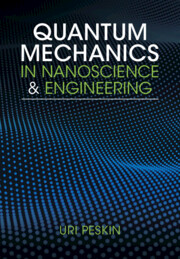Book contents
- Quantum Mechanics in Nanoscience and Engineering
- Additional material
- Quantum Mechanics in Nanoscience and Engineering
- Copyright page
- Contents
- Preface: Who Can Benefit from Reading This Book?
- 1 Motivation
- 2 The State of a System
- 3 Observables and Operators
- 4 The Schrödinger Equation
- 5 Energy Quantization
- 6 Wave Function Penetration, Tunneling, and Quantum Wells
- 7 The Continuous Spectrum and Scattering States
- 8 Mechanical Vibrations and the Harmonic Oscillator Model
- 9 Two-Body Rotation and Angular Momentum
- 10 The Hydrogen-Like Atom
- 11 The Postulates of Quantum Mechanics
- 12 Approximation Methods
- 13 Many-Electron Systems
- 14 Many-Atom Systems
- 15 Quantum Dynamics
- 16 Incoherent States
- 17 Quantum Rate Processes
- 18 Thermal Rates in a Bosonic Environment
- 19 Open Quantum Systems
- 20 Open Many-Fermion Systems
- Index
- References
12 - Approximation Methods
Published online by Cambridge University Press: 11 May 2023
- Quantum Mechanics in Nanoscience and Engineering
- Additional material
- Quantum Mechanics in Nanoscience and Engineering
- Copyright page
- Contents
- Preface: Who Can Benefit from Reading This Book?
- 1 Motivation
- 2 The State of a System
- 3 Observables and Operators
- 4 The Schrödinger Equation
- 5 Energy Quantization
- 6 Wave Function Penetration, Tunneling, and Quantum Wells
- 7 The Continuous Spectrum and Scattering States
- 8 Mechanical Vibrations and the Harmonic Oscillator Model
- 9 Two-Body Rotation and Angular Momentum
- 10 The Hydrogen-Like Atom
- 11 The Postulates of Quantum Mechanics
- 12 Approximation Methods
- 13 Many-Electron Systems
- 14 Many-Atom Systems
- 15 Quantum Dynamics
- 16 Incoherent States
- 17 Quantum Rate Processes
- 18 Thermal Rates in a Bosonic Environment
- 19 Open Quantum Systems
- 20 Open Many-Fermion Systems
- Index
- References
Summary
Exact solutions to the Schrödinger equation for realistic nanoscale systems are beyond reach, hence, different strategies for approximating the solutions are necessary. Perturbation theory relies on a “zero-order Hamiltonian” to express the desired eigenvalues and eigenvectors of “the full Hamiltonian.” We derive working equations for the Rayleigh–Schrödinger perturbation theory, and the validity of the approach is analyzed for a generic two-level system. Applications are given to atoms perturbed by point charges or static fields, and for electrons in quantum wells. An alternative strategy is the variation method, which replaces exact solutions by their projection on a reduced space of “trial functions,” varied to minimize the associated error. Particularly important is the method of linear variation, which can potentially converge to the exact Hamiltonian eigenstates. The mean-field approximation, commonly used for many-particle systems, is derived by optimizing a trial function in the form of product of single-particle functions.
Keywords
Information
- Type
- Chapter
- Information
- Quantum Mechanics in Nanoscience and Engineering , pp. 155 - 199Publisher: Cambridge University PressPrint publication year: 2023
